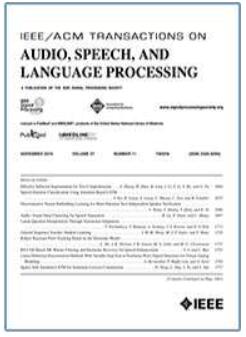$\mathcal {P}$owMix:用于多模态情感分析的多功能正则化器
IF 5.1
2区 计算机科学
Q1 ACOUSTICS
IEEE/ACM Transactions on Audio, Speech, and Language Processing
Pub Date : 2024-11-11
DOI:10.1109/TASLP.2024.3496316
引用次数: 0
摘要
多模态情感分析(MSA)利用异构数据源来解读人类情感的复杂本质。尽管多模态架构设计取得了重大进展,但该领域仍缺乏全面的正则化方法。本文介绍了$\mathcal {P}$owMix,这是一种多功能嵌入空间正则化方法,它借鉴了基于单模态混合的正则化方法的优点,并引入了专门为多模态任务定制的新型算法组件。$\mathcal {P}$owMix 集成在多模态架构的融合阶段之前,并促进模态内混合,如文本与文本混合,以充当正则化器。{P}$owMix由五个部分组成:1)生成混合示例的不同数量;2)混合因子重新加权;3)各向异性混合;4)动态混合;5)跨模态标签混合。在基准 MSA 数据集和各种不同的架构设计中进行的广泛实验证明了 $mathcal {P}$owMix 的功效,其性能比基线和现有混合方法有了持续改善。一项深入的烧蚀研究强调了每个 $\mathcal {P}$owMix 组件的关键贡献,以及它们如何协同提高性能。此外,算法分析展示了$\mathcal {P}$owMix在不同场景下的表现,尤其是早期与晚期融合架构的比较。值得注意的是,$\mathcal {P}$owMix 在不牺牲模型鲁棒性或放大文本优势的情况下提高了整体性能。在数据有限的情况下,它也能保持强劲的性能。我们的研究结果表明,$\mathcal {P}$owMix 是一种很有前途的 MSA 多用途正则化策略。本文章由计算机程序翻译,如有差异,请以英文原文为准。
$\mathcal {P}$owMix: A Versatile Regularizer for Multimodal Sentiment Analysis
Multimodal sentiment analysis (MSA) leverages heterogeneous data sources to interpret the complex nature of human sentiments. Despite significant progress in multimodal architecture design, the field lacks comprehensive regularization methods. This paper introduces
$\mathcal {P}$ $\mathcal {P}$ $\mathcal {P}$ $\mathcal {P}$ $\mathcal {P}$ $\mathcal {P}$ $\mathcal {P}$ $\mathcal {P}$
求助全文
通过发布文献求助,成功后即可免费获取论文全文。
去求助
来源期刊

IEEE/ACM Transactions on Audio, Speech, and Language Processing
ACOUSTICS-ENGINEERING, ELECTRICAL & ELECTRONIC
CiteScore
11.30
自引率
11.10%
发文量
217
期刊介绍:
The IEEE/ACM Transactions on Audio, Speech, and Language Processing covers audio, speech and language processing and the sciences that support them. In audio processing: transducers, room acoustics, active sound control, human audition, analysis/synthesis/coding of music, and consumer audio. In speech processing: areas such as speech analysis, synthesis, coding, speech and speaker recognition, speech production and perception, and speech enhancement. In language processing: speech and text analysis, understanding, generation, dialog management, translation, summarization, question answering and document indexing and retrieval, as well as general language modeling.
 求助内容:
求助内容: 应助结果提醒方式:
应助结果提醒方式:


